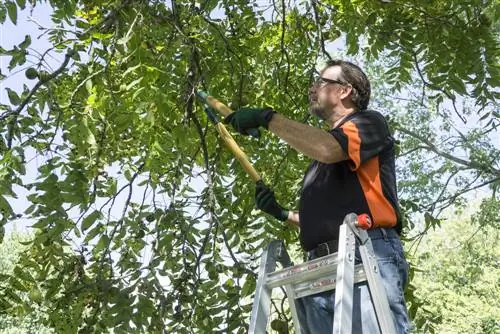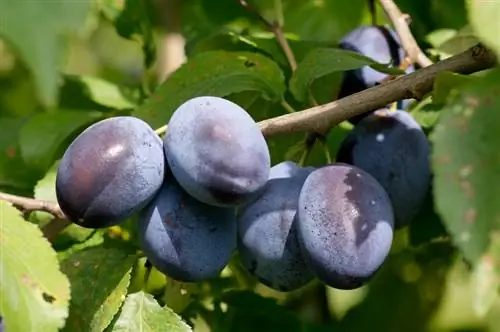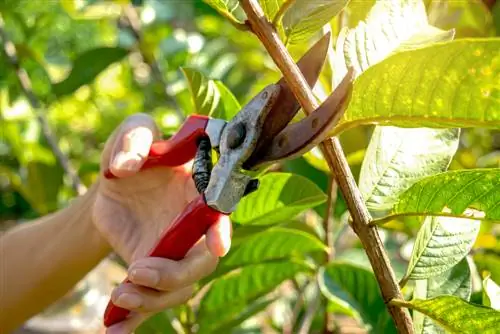- Author admin [email protected].
- Public 2023-12-16 16:46.
- Last modified 2025-01-23 11:21.
Crunchy home-grown walnuts are within reach when there is a walnut tree in the garden. Careful training and occasional trimming guarantee uninterrupted enjoyment of the mighty tree. In this tutorial, read when and how to prune a walnut tree.
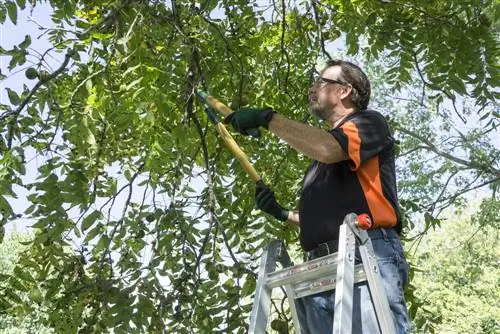
When and how should you prune a walnut tree?
To prune a walnut tree correctly, carry out training pruning on young trees in early autumn and shape the crown with a vertical central shoot and lateral leading branches. Topiary pruning can be done every 5 to 10 years, taking into account the pruning of thicker shoots.
Walnut tree is bleeding heavily
A real walnut tree (Juglans regia) grows slowly but steadily to an impressive 25 meters high. Garden-suitable walnut trees grafted onto black walnut (Juglans nigra) also reach impressive heights with a crown diameter of 8 to 10 meters. Reason enough to train a walnut tree at a young age and to subject it to occasional pruning as it gets older. If it weren't for the massive flow of juice that accompanies every cut, no matter how small.
In the middle of the growing season, veritable torrents of plant sap stream out of an open wooden body. The reason is the strong sap pressure, which is at its highest level in spring and only subsides over the course of summer.
Bleeding is not life-threatening
Streams of sap on the walnut tree are often a headache for hobby gardeners. There is great concern that so-called bleeding could cause the magnificent tree to die. In fact, it is anatural reaction to wounds of all kinds, as is known from other tree species, such as globe maple.
You can't stop the flow of juice. Tree wax and other wound closure products do not adhere to the wet surface. Burning out cuts destroys the valuable dividing tissue (cambium) under the bark. Without cambium, wound healing is not possible, so the wound will never close. The remedy of choice against bleeding on the walnut tree is a wisely chosen time of pruning.
Cut in early fall
If you have prescribed pruning for your walnut tree, the best time to prune is in early autumn. As the leaves fall, the sap flow temporarily reduces to a tolerable level. The tree is preparing for winter rest and now no longer wants to grow. A cutting appointmentbeginning of October scores with three important advantages:
- Juice pressure at lowest level of the year
- Sufficient time window for wound healing until the first frost
- Date selection in accordance with the Federal Nature Conservation Act
From October 1st, the Federal Nature Conservation Act allows cutting of all types of trees because the birds' breeding season ends at this point. Although the new grace period does not begin again until March 1st, the pruning of the walnut treeshould be completed by mid-November.
Tip
Autumn is not just the best time for a cut. September to November is also the ideal time window for planting a walnut tree. Inexpensive bare-root products and young trees with bales grow quickly in the warm, sunny garden soil. Add some mature compost to the planting pit as a natural jump start for he althy growth.
Building a shapely crown - parenting cut
Nursery schools and garden centers offer walnut in a garden-friendly version as a refined young tree on a robust base. “Clone No. 139” is very popular because its later shoots are less at risk from late frosts. Refined walnuts bear their first fruit after just 5 to 6 years, whereas real walnuts take up to 30 years to bloom for the first time. The upright, richly branched growth of premium varieties as a refinement offers the perfect starting point for training to become a shapely tree, as illustrated in the figure below. This is how the parenting process works:
- In the first 4 to 6 years, carry out training in early autumn
- Build the crown with a vertical central shoot and 3 lateral guide branches
- Select leading branches with different starting points and an angle between 45° and 90° to the trunk
- Do not cut the tip of the central shoot
The education phase focuses on removingvertical competitive instincts in a timely manner. This applies equally to steep shoots on the leading branches and from the base or trunk. Only prune leading branches if they grow at different lengths. The top buds should be in the juice level at all times. The tip bud of the central shoot is one or two scissor lengths above the leading branches. Together, the framework forms an angle of 90° to 120° for an exemplary round crown.
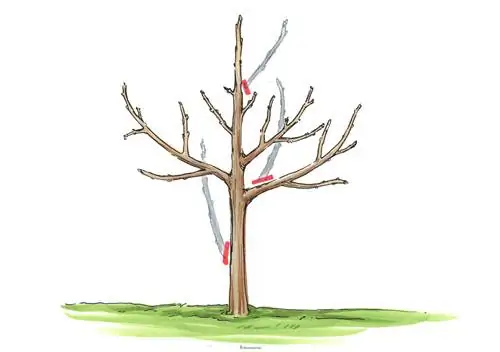
Treat the crown with a vertical central shoot and three lateral leading branches. Wild shoots from the rootstock and trunk are removed promptly. Steep shoots that compete with the scaffolding must give way.
Excursus
Tie down steep shoots preferably
The walnut differs from apples, pears and cherries in many ways. When it comes to the fertility of shoots, a walnut tree works together with pome and stone fruit trees. As long as a shoot grows vertically towards the sky, the growth law of top promotion rules. The walnut has no interest in producing flower buds at this point. Before you remove a steep shoot from the crown in a sunny position, you should use its potential as fruit wood. To do this, tie or spread the young, still flexible branch at an angle of approximately60° to the trunk or leading branch The growth comes to rest so that flowers and nuts can form.
Cut treetop into shape
A properly trained walnut tree rarely requires pruning. The most common cause is unwanted expansion in all directions, which makes a reduction in the size of the crown unavoidable. A walnut that is sensitive to cuts tolerates intervention with scissors and saws at intervals of 5 to 10 years. With this cut you can bring a walnut tree back into shape:
- The best time is between the beginning of October and mid-November in dry weather
- Cut off shoots that are at an acute angle to the trunk or leading branch
- Remove or tie down steep shoots sprouting on the leading branches
- Cut back excessively long scaffolding branches by a maximum of 150 cm
- Slender massively branched shoot tips through derivation
- Cut branches from 5 cm in diameter to 20 cm long cones
- Step back after each cut to plan what to do next

A walnut tree benefits from being familiar with a derivation pruning. This is used if you want toshortena scaffolding branch that is too long or want toslim a broom-like branched branch tip. Near the cut point, look for an outward-facing, young side shoot. Cut off the used wood at the fork. To ensure that the young shoot is not injured, place the scissors or saw a few millimeters into the old wood.

Every 5 to 10 years your walnut tree can cope with a topiary. You can thin out dead wood and steep shoots by cutting them into cones. Strongly branched and overly long scaffold branches lead you to a favorable side shoot.
Background
Fruit woodcut useless
Only record a cut on the walnut tree if the crown has grown too large or shapeless. Fruit wood cutting to increase crop yields is not worth the effort. In contrast to fruit trees with stone or pome fruit, annual pruning measures to promote young fruit wood on walnuts come to nothing. Rather, site conditions and weather determine the quantity and fruit quality of a harvest.
Cut gently into tenons
The rare pruning of the walnut tree can cause larger cuts. The main branches of a crown are usually affected, on the top of which unwanted steep shoots or similarly unfavorable branches have to be removed. A cut on Astring carries the risk that the wound will dry back deep into the wood and fatal rot will form. A more gentle way is to make a cut on a tenon. How to do it right:
- Cut off thick shoots from the main branch or trunk with 20 to 25 cm long cones
- Consequential phenomenon: Cone gradually dries back by half
- After 2 to 3 years, remove dried cone residue in autumn
According to this strategy, dead or damaged scaffold shoots should also be removed from the crown. The particular advantage of the cutting technique is that young shoots grow from a cone base. After a few years, select the most promising, diagonally growing shoot as the new leading branch and remove the others.
Frequently asked questions
Is a walnut tree self-fertile?
Walnut trees are monoecious and therefore self-fertile. There are female and male flowers on a tree. The male flowers can be identified as hanging, yellowish-green catkins. They appear in April about four weeks before the inconspicuous female inflorescences. Pollination occurs by wind. A single tree is enough to produce a harvest of crunchy walnuts.
Should a walnut tree be supported with a stake during training? If so, when can the support be removed again?
A support pile fulfills two important tasks. Its primary purpose is to ensure straight growth of the trunk and central shoot. In addition, it prevents wind breakage, which is particularly a concern on young and thin shoots. Only when a walnut tree has grown well and has formed a thick, stable and stable trunk can the post be removed. The more wind-exposed the location, the longer you should wait.
Is it possible to limit the growth of a real walnut (not refined)? I'm thinking about cutting off the leading tip
Walnut trees naturally grow quite large. Trees that have not been grafted, especially those propagated from seeds, reach a height of 20 meters or more. There is the option of regulating growth right from the start through training. If you want to keep a real walnut more compact and smaller overall, trim the crown all around. If you just cut the guide tip, it will grow massively in width. The best time is parallel to the autumn leaf fall between the beginning of October and mid-November. At all other times of the year there is a strong flow of sap, which significantly impairs wound healing.
Is it possible to keep a real walnut tree in a pot for 10 years? If so, how big should the pot be and what should you pay particular attention to?
In principle, it is possible to keep walnut trees in containers. In contrast to outdoors, a walnut in a pot requires significantly more care. The substrate dries out more quickly and after a short time has hardly any nutrients to offer. Regular watering and fertilizing is essential. A 20 liter bucket is sufficient to start with, but not for a period of 10 years. The pot should gradually grow to a volume of 200 liters when the tree has reached a height of 6 to 7 meters. For this purpose, repot the walnut tree every 2 to 3 years.
Two years ago I planted a real walnut that shot up from 90 centimeters to almost 200 centimeters. Unfortunately, not a single side shoot has formed so far. I actually didn't want the walnut to be that big. What to do?
Walnut trees naturally have a hard time with lush branching. Over time, a few side shoots will gradually form. You can speed up the process by cutting the shoot tip to 150 or 180 cm. Cut just above a strong bud. In this way you create a sap build-up in deeper buds, which then sprout. There won't be more than two or three side shoots. After all, this number is enough to grow a beautiful crown from it.
The 3 most common cutting mistakes
Without pruning, a walnut tree will sooner or later grow over your head. If a topiary is done at the wrong time, the magnificent tree risks bleeding to death. A walnut suffers a similar fate if its branches are not cut into cones. The following overview draws attention to the three most common cutting errors and provides tried-and-tested tips for prevention:
| Cutting errors | malicious image | Prevention |
|---|---|---|
| no parenting cut | uncontrolled growth, misshapen crown | Train crown with central shoot and 3 leading branches |
| cut in summer or winter | massive sap flow | cut in early autumn |
| Thicker shoots not cut onto cones | slow wound healing, spread of wood rot | cut into tenons from a diameter of 5 cm |
Tip
The wood quality of walnut trees is on par with precious woods such as mahogany or teak. In addition to the visual advantages, the wood is characterized by a fine-grained and medium-hard structure. When it comes to cutting care, these attributes mean a low tendency to splintering and little effort required when cutting. To cut twigs and branches up to 3 cm in diameter, we recommend using pruning shears (€25.00 on Amazon) with a bypass mechanism, which leaves smooth cuts.

